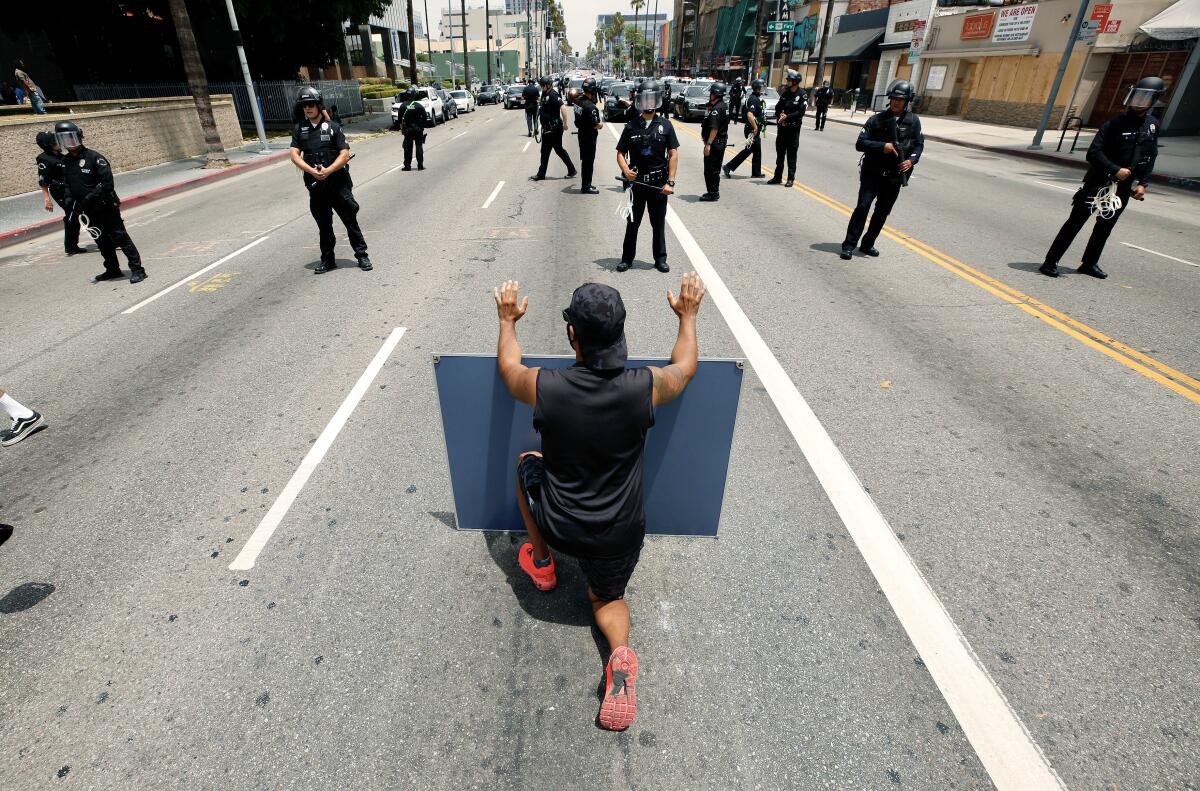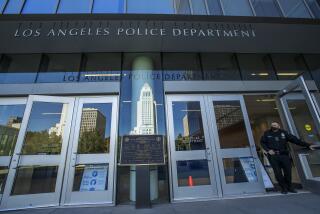Police Commission gives LAPD two weeks to set priorities for improvements

- Share via
The Los Angeles Police Commission on Tuesday gave top LAPD officials two weeks to consolidate three recent reports on the department’s handling of last spring’s protests into a single plan of action that identifies top reform priorities, estimates associated costs and sets a timeline for implementation.
“Let’s get everything on the table as to what we need to do,” said Commissioner Eileen Decker, president of the civilian oversight panel.
The order followed presentations on each of the three reports — which all found glaring issues with the LAPD’s training, preparation and response — and questions from commissioners on how their recommendations overlapped.
The commissioners did not address which recommendations they agreed with, but said the LAPD’s consolidation report would help inform a collaborative effort in coming weeks and months by the commission, the City Council and Mayor Eric Garcetti’s office to formulate an official path forward.
Decker said she looked forward to a “robust list of improvements.”
Two more reviews have found glaring problems with the Los Angeles Police Department’s handling of last summer’s mass protests against police brutality.
The underlying reports — one from the LAPD, one for the City Council from attorney Gerald Chaleff and one for the commission from the National Police Foundation — all concluded that the LAPD’s response to the historic protests against police brutality was hampered by poor planning, training and leadership in the field.
Among other issues, the reports found that officers armed with hard-foam projectile weapons were not properly trained on how to use them, that the department lacked sufficient resources and plans to efficiently and safely process the thousands of people they arrested, and that commanders had contributed to the chaos by issuing contradictory orders and diverging from best practices for mass demonstrations.
They recommended more training for officers, a more constant and regular assessment by LAPD leaders of needs related to future demonstrations, and streamlined processes for documenting such encounters.
The protests in late May and early June, which followed police killings of Black people in other cities including George Floyd in Minneapolis and Breonna Taylor in Louisville, Ky., devolved in L.A. into intense clashes between officers in riot gear and large crowds of demonstrators while shops and other businesses were burglarized and set ablaze — costing, by one LAPD estimate, nearly $170 million in private losses.
Police have said they attempted to facilitate the demonstrations until they became dangerous and violent. Protesters have contended police in riot gear escalated tensions and deserve much of the blame for things spiraling out of control.
The commission’s discussion Tuesday followed criticism from prominent community organizations and callers into the commission’s virtual meeting that the three reports were produced without sufficient community input and ignored calls for the police to be defunded, not pumped with more resources.
Greg Akili, an activist with Black Lives Matter Los Angeles, said the city responded to major protests and unrest in the 1960s and 1990s by giving the department more resources, only for the LAPD to keep abusing protesters.
The LAPD is being sued for violence against protesters — again. The department committed to policy changes after incidents in 2000 and 2007.
“It’s the same thing: more studies, more money for this or that, and the result is always the same,” Akili said.
Hamid Khan, of the Stop LAPD Spying Coalition, said an honest reflection on last year’s protests would lead officials to start dismantling the LAPD.
“At what point do we start realizing in this post-mortem that this body is rotten to the core, that you can’t salvage this?” Khan asked.
Police officials and commissioners struck a more optimistic tone, but acknowledged that the issues confronting the department are thorny.
They said the LAPD’s rank-and-file has already been reduced in size, and that adding more training to the already crowded schedules of front-line officers could be complicated. They said the LAPD’s command staff has been depleted through attrition, and needs to be built back with competent leaders who are well-versed in crowd control scenarios to be effective at future demonstrations.
LAPD Chief Michel Moore said he intended to return a report that sets benchmarks for the next three to six months and longer-term goals while considering current demands and constraints on the department. He said he hopes to address the changing landscape of protests by identifying “new strategies, new techniques [and] new tools” for protecting protesters, the community and officers while preventing violence and destruction.
“This is only going to become more complex,” Moore said.
Lizabeth Rhodes, director of the LAPD’s Office of Constitutional Policing and Policy, said her goal was to return in two weeks with “as good a product as we can” on the most effective path forward for implementing prioritized reforms.
“This is a very long journey that we have to go on,” she said.
At one point in the discussion, Commissioner William Briggs asked the authors of the three reports if they believed the LAPD should ban the use of 40-millimeter projectiles in crowd control settings. Protesters and other litigants have alleged in lawsuits that such weapons were used in abusive ways and caused serious injuries, some of which The Times has documented.
The report authors said additional training was needed, but pushed back against the idea of a ban in situations like May and June, where they said officers and community members were placed in danger.
“This was an event where rocks, bottles, other material, fireworks, bleach was thrown at officers, and while many, many in the crowd were peaceful, there were those in the crowd that would do harm both to property and to individuals, specifically police officers,” Rhodes said. “You need something to direct at those rogue members of the crowd.”
More to Read
Sign up for Essential California
The most important California stories and recommendations in your inbox every morning.
You may occasionally receive promotional content from the Los Angeles Times.












